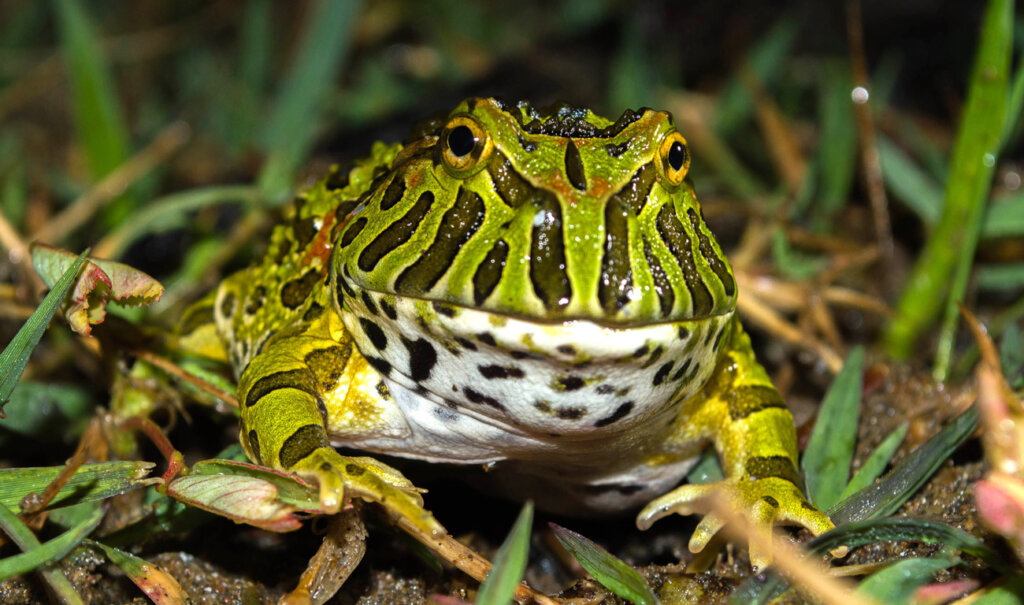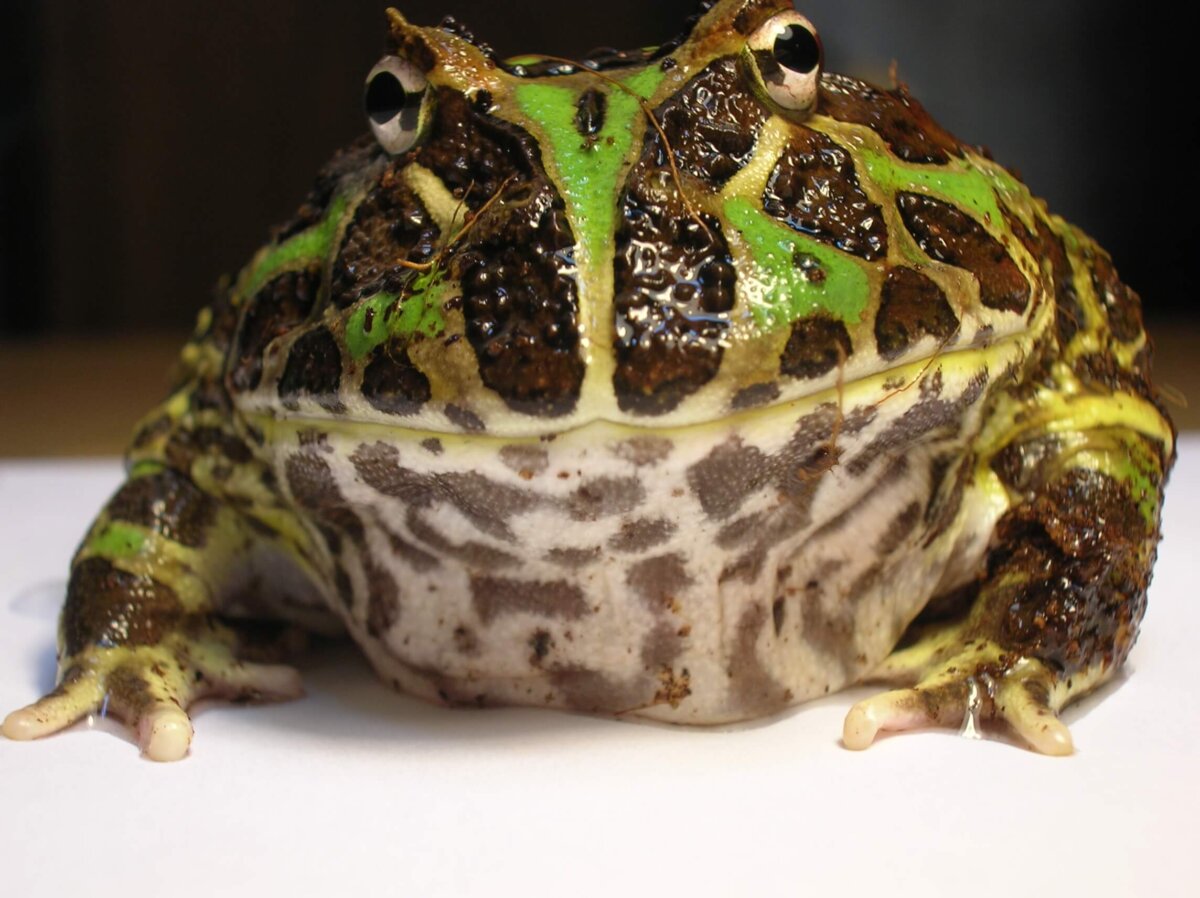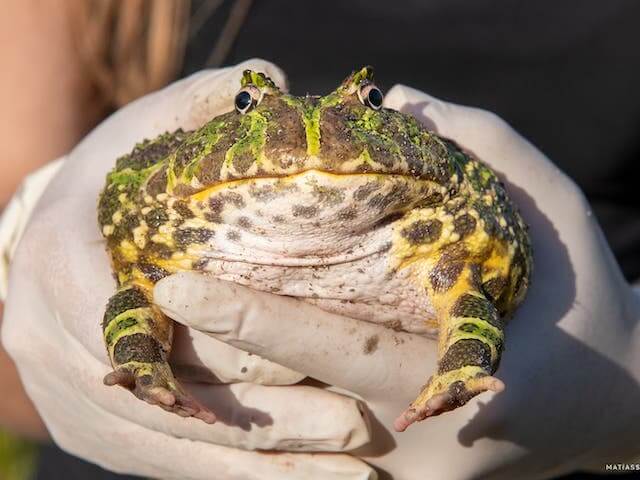Argentine Horned Frog: Habitat, Feeding and Characteristics

The Argentine horned frog, like the rest of the anurans of the genus Ceratophrys, is also known as the pacman frog due to its huge mouth, which takes up almost half of its body. Also noteworthy are the protuberances it has on its head, which are similar to small horns, hence its name
Although many people know it by this reference to the classic video game, the truth is that this frog has many interesting features that are often overlooked. So, here’s a complete fact sheet on its biological makeup and behavior that you simply can’t miss. Let’s go!
Characteristics and taxonomy

The Argentine horned frog (Ceratophrys ornata) is an anuran amphibian that belongs to the Ceratophryidae family, which includes all frogs popularly known as sculpins. The one we’re dealing with is the common version, characterized by its bright green coloration and black spots.
There are some signs that indicate sexual dimorphism, as males usually have nuptial pads on their forelimbs and somewhat loose skin on the lower part of their mouth, where the vocal sac is located. Females, on the other hand, are much larger, reaching 16 centimeters (over 6 inches) in length, while males only reach 10 centimeters (4 inches).
Its huge mouth, which covers almost half of its total length, helps it to consume quite large prey, such as small rodents. Inside the mouth opening, there’s a row of small, pointed teeth at the top and two odontoid, fang-like protuberances on the lower jaw.
These small fangs help them to catch their prey more effectively.
Argentine horned frog: habitat
The Argentine horned frog can be found in Argentina (hence its name), in the Pampa region, Buenos Aires, Córdoba, Entre Ríos, Mendoza and Santa Fe. It can also be seen in tropical areas of Brazil and Uruguay, but the largest populations are found in Argentina.
Its habitat includes meadows with shallow bodies of water, as this frog isn’t a very good swimmer despite its semi-aquatic condition. It’s also possible to see them in roadside ditches and irrigated farmland.
These frogs are characterized by their great voracity, as anything that’s alive and passes in front of them is on the menu! In fact, their hunting style consists of burying themselves in the mud, leaving only their eyes visible. When prey approaches, they jump up and catch it.
They’re so voracious that it isn’t unusual for them to suffocate to death trying to eat an animal that’s fat too large for it.
Therefore, the Argentine horned frog is a carnivorous species that consumes, above all, vertebrates. Its diet includes other anurans, small birds, rodents, and any other animals it can hunt. Their tadpoles, unlike other species, are also carnivorous.
Argentine horned frog behavior
Although they’re amphibians, they spend most of their lives only on land. They are nocturnal and solitary, being found only during the breeding season.
During the winter, which is the coldest and driest season for them, they hibernate by burying themselves completely. To prevent their skin from drying out during this period, they create a kind of crust around themselves that preserves skin moisture.
They’re generally territorial animals and tend to defend themselves through threats and aggression. Before attacking, however, they will open their mouths wide, so that they appear larger than they really are, with the hope of scaring away possible predators or competitors. Their tadpoles, on the other hand, emit a metallic screeching sound underwater for defensive purposes and to warn of the threat.
Reproduction
In early spring with the rains, the Argentine horned frog emerges from hibernation and the reproductive season begins. Prior to copulation, the male emits a specific, loud and monotonous song. Upon finding a mate, the male and female will join in the typical embrace known as amplexus, at which time fertilization occurs.
The female is capable of laying up to 2000 eggs just a few weeks after copulation. The eggs adhere to different surfaces that later end up in the water, such as plants, rocks, wood, etc. Depending on the water temperature, after 2-4 days the tadpoles will hatch.
The metamorphosis that will allow the tadpoles to breathe air doesn’t occur until 4-6 weeks later. In the meantime, they’ll feed in the water on whatever they find, especially insects and other aquatic animals, even resorting to cannibalism if they can’t find anything else.
Conservation status of the Argentine horned frog

Ceratophrys ornata is currently in Near Threatened (NT) status. Like most anurans, the greatest threat they face is habitat loss and pollution of their environment. In particular, the Argentine horned frog is also collected for commercialization as a pet and to sell its eggs for scientific research.
Although protected areas and conservation sites are being created, much research is still needed on the populations of these anurans, as well as their ecology and behavior. Therefore, they aren’t yet safe from the decline they’re already suffering. It’s up to all of us to give them the importance they deserve so that they continue to live freely on our planet.
All cited sources were thoroughly reviewed by our team to ensure their quality, reliability, currency, and validity. The bibliography of this article was considered reliable and of academic or scientific accuracy.
- Axel Kwet, Gabriel Skuk, Débora Silvano, Esteban Lavilla, Ismael di Tada, Rafael Lajmanovich. 2004. Ceratophrys ornata . La Lista Roja de Especies Amenazadas de la UICN 2004: e.T56340A11464790. https://dx.doi.org/10.2305/IUCN.UK.2004.RLTS.T56340A11464790.en . Consultado el 23 de noviembre de 2022.
- Deutsch, C., Bilenca, D., & Agostini, G. (2017). In search of the horned frog (Ceratophrys ornata) in Argentina: complementing field surveys with citizen science. Herpetological Conservation and Biology, 12(3), 664-672.
- Groom, D. J., Kuchel, L., & Richards, J. G. (2013). Metabolic responses of the South American ornate horned frog (Ceratophrys ornata) to estivation. Comparative Biochemistry and Physiology Part B: Biochemistry and Molecular Biology, 164(1), 2-9.
- Costa, C. S., Ronco, A. E., Trudeau, V. L., Marino, D., & Natale, G. S. (2018). Tadpoles of the horned frog Ceratophrys ornata exhibit high sensitivity to chlorpyrifos for conventional ecotoxicological and novel bioacoustic variables. Environmental Pollution, 235, 938-947.
